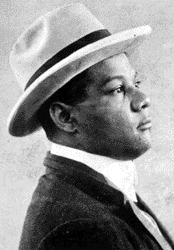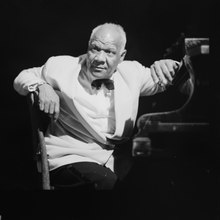Shipping from Europe with tracking number / Jacques Hardy 1978
PARIS MINT 1978 ,SILVER FRENCH ART HEAVY MEDAL 70mm,210gr fine silver
Sidney Bechet
Sidney Bechet | |
|---|---|
 Photographic portrait of Bechet at Jimmy Ryan's Club in New York, 1947, by William P. Gottlieb | |
| Background information | |
| Birth name | Sidney Joseph Bechet |
| Born | May 14, 1897 New Orleans, Louisiana, United States |
| Died | May 14, 1959 (aged 62) Garches, France |
| Genres | Jazz, Dixieland |
| Occupation(s) | Musician, composer |
| Instruments | Clarinet, soprano saxophone |
| Years active | 1908–1957 |
| Associated acts | Louis Armstrong, Tommy Ladnier |
Sidney Joseph Bechet[1] (May 14, 1897 – May 14, 1959) was an American jazz saxophonist, clarinetist, and composer. He was one of the first important soloists in jazz, and first recorded several months before trumpeter Louis Armstrong.[2] His erratic temperament hampered his career, and not until the late 1940s did he earn wide acclaim.
Bechet in France
On September 15, 1925, Bechet and other members of the Revue Nègre, including Josephine Baker, sailed to Europe, arriving at Cherbourg, France, on September 22. The revue opened at the Théâtre des Champs-Élysées[7] in Paris on October 2. The show was an example of negrophilia in France at the time.[8] He toured Europe with multiple bands, reaching as far as Russia in mid-1926. In 1928, he led his small band at Chez Bricktop (run by the popular Ada "Bricktop" Smith) in Montmartre, Paris.
He was imprisoned in Paris for eleven months.[9][10] In his autobiography, he wrote that he accidentally shot a woman when he was trying to shoot a musician who had insulted him. He had challenged the man to duel and said, "Sidney Bechet never plays the wrong chord."[11] After his release, he was deported to New York, arriving soon after the stock market crash of 1929. He joined with Lorenzo Tio and also came to know trumpeter Roy Eldridge.[6]
In 1932, Bechet returned to New York City to lead a band with Tommy Ladnier. The band, consisting of six members, performed at the Savoy Ballroom. He played in Noble Sissle's orchestra, which toured in Germany and Russia.
Later Life
In 1938, "Hold Tight, Hold Tight (Want Some Seafood Mama)", commonly known as "Hold Tight", was composed by Bechet's guitarist Leonard Ware and two session singers with claimed contributions from Bechet himself. The song became known for its suggestive lyrics and then for a series of lawsuits over songwriter royalties.
In 1939, Bechet and the pianist Willie "The Lion" Smith led a group that recorded several early versions of what was later called Latin jazz, adapting traditional méringue, rhumba and Haitian songs to the jazz idiom. On July 28, 1940, Bechet made a guest appearance on the NBC Radio show The Chamber Music Society of Lower Basin Street, playing two of his showpieces ("Shake It and Break It" and "St. Louis Blues") with Henry Levine's Dixieland band. Levine invited Bechet into the RCA Victor recording studio (on 24th Street in New York City), where Bechet lent his soprano sax to Levine's traditional arrangement of "Muskrat Ramble". On April 18, 1941, as an early experiment in overdubbing at Victor, Bechet recorded a version of the pop song "The Sheik of Araby", playing six different instruments: clarinet, soprano saxophone, tenor saxophone, piano, bass, and drums. A hitherto unissued master of this recording was included in the 1965 LP Bechet of New Orleans, issued by RCA Victor as LPV-510. In the liner notes, George Hoeffer quoted Bechet:
In 1944, 1946, and 1953, he recorded and performed in concert with the Chicago jazz pianist and vibraphonist Max Miller; private recordings from Miller's archive have never been released. These concerts and recordings are described in John Chilton's biography Sidney Bechet: The Wizard of Jazz.[12]
With jobs in music difficult to find, he opened a tailor shop with Ladnier. They were visited by musicians and played in the back of the shop. In the 1940s, Bechet played in several bands, but his financial situation did not improve until the end of that decade. By the end of the 1940s, Bechet had tired of struggling to make music in the United States. His contract with Jazz Limited, a Chicago-based record label, was limiting the events at which he could perform (for instance, the label would not permit him to perform at the 1948 Festival of Europe in Nice). He believed that the jazz scene in the United States had little left to offer him and was getting stale.[6]
Permanent Settlement in Paris
In 1951, he migrated to France permanently,[4] after his performance as a soloist at the Paris Jazz Fair caused a surge in his popularity in that country, where he easily found well-paid work. Also in 1951, he married Elisabeth Ziegler in Antibes.
In 1953, he signed a recording contract with Disques Vogue that lasted for the rest of his life.[6] He recorded many hit tunes, including "Les Oignons", "Promenade aux Champs-Elysees", and the international hit "Petite Fleur". He also composed a classical ballet score in the late Romantic style of Tchaikovsky called La Nuit est une sorcière ("The Night Is a Witch"). Some existentialists in France took to calling him le dieu ("the god").[13]
Autobiography & Death
Shortly before his death, Bechet dictated his autobiography, Treat It Gentle, to Al Rose, a record producer and radio host. He had worked with Rose several times in concert promotions and had a fractious relationship with him. Bechet's view of himself in his autobiography was starkly different from the one Rose knew.
"The kindly old gentleman in his book was filled with charity and compassion. The one I knew was self-centered, cold, and capable of the most atrocious cruelty, especially toward women."[14]
Although embellished and frequently inaccurate, Treat It Gentle remains a staple account for the "insider's view of the New Orleans tradition."[15]
Bechet died in Garches, near Paris, of lung cancer on May 14, 1959 on his 62nd birthday. He is buried in a local cemetery.[1]
Post-Death Developments
In 2013, a crater on Mercury was named after Bechet.[16]
On June 25, 2019, The New York Times Magazine listed Sidney Bechet among hundreds of artists whose material was reportedly destroyed in the 2008 Universal fire.

